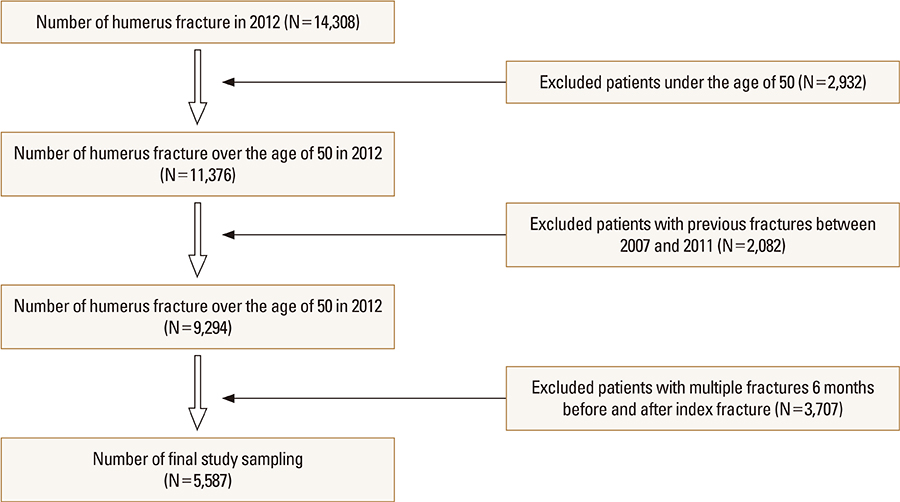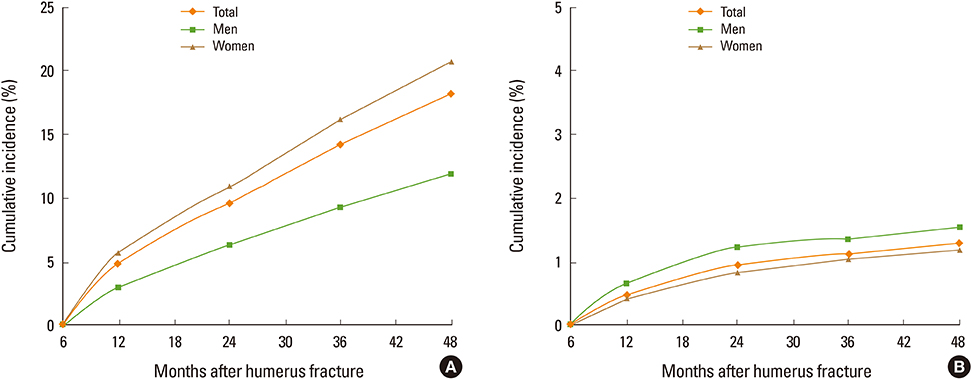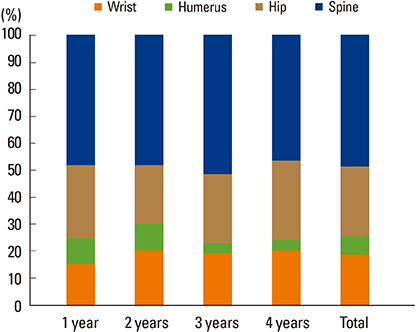J Bone Metab.
2019 May;26(2):105-111. 10.11005/jbm.2019.26.2.105.
Incidence of Osteoporotic Refractures Following Proximal Humerus Fractures in Adults Aged 50 Years and Older in Korea
- Affiliations
-
- 1Department of Orthopaedic Surgery, Chung-Ang University College of Medicine, Seoul, Korea.
- 2Department of Orthopedic Surgery, Soonchunhyang University Seoul Hospital, Soonchunhyang University College of Medicine, Seoul, Korea.
- 3College of Pharmacy and Gachon Institute of Pharmaceutical Sciences, Gachon University, Incheon, Korea.
- 4Division of Endocrinology, Department of Internal Medicine, Wonkwang University Sanbon Hospital, Wonkwang University School of Medicine, Gunpo, Korea.
- 5Department of Orthopaedic Surgery, Gyeongsang National University Hospital, Jinju, Korea.
- 6Department of Orthopaedic Surgery, Seoul National University Bundang Hospital, Seoul National University College of Medicine, Seongnam, Korea. ykleemd@gmail.com
- KMID: 2448958
- DOI: http://doi.org/10.11005/jbm.2019.26.2.105
Abstract
- BACKGROUND
The purpose of this study was to investigate the incidence and characteristics of osteoporotic refractures after proximal humerus fracture in Korean adults aged above 50 years.
METHODS
Patients aged 50 years or older with initial proximal humerus fractures reported in 2012 were enrolled and followed up until 2016 using the Korean National Health Insurance data. Based on the last claim date, the refractures were classified as osteoporotic fractures including spine, hip, distal radius, and humerus 6 months after the index fracture involving the proximal humerus. Each osteoprotic fracture was identified using specific International Classification of Diseases, 10th Revision codes and site-specific physician claims for procedures.
RESULTS
A total of 5,587 first-time fractures involving proximal humerus were reported in 2012. Among them, a total of 1,018 osteoporotic refractures occured between 2012 and 2016. The total cumulative incidence of osteoporotic refractures was 4.85% (271/5,587) at 1 year, 9.61% (537/5,587) at 2 years, 14.21% (794/5,587) at 3 years, and 18.22% (1,018/5,587) at 4 years. In terms of site by year, the incidence of associated refractures was as follows: spine, 48.62% (495/1,018); hip, 25.83% (263/1,018); wrist 18.57% (189/1,018); and humerus 6.97% (71/1,018) during all the follow-up periods.
CONCLUSIONS
Our study showed that the cumulative incidence of osteoporotic refractures following proximal humerus fractures in the elderly population has been increasing over the years. Given that osteoporotic refractures are associated with an increased mortality risk, a public health strategy to prevent the refracture after proximal humerus fracture in the elderly is imperative.
MeSH Terms
Figure
Cited by 3 articles
-
Population-based Analysis for Risk of Suicide Death in Elderly Patients after Osteoporotic Fracture: a Nested Case-Control Study
Suk-Yong Jang, Yonghan Cha, Je Chan Lee, Hayong Kim, Kap-Jung Kim, Wonsik Choy
J Korean Med Sci. 2021;36(36):e225. doi: 10.3346/jkms.2021.36.e225.Introducing big data analysis using data from National Health Insurance Service
EunJin Ahn
Korean J Anesthesiol. 2020;73(3):205-211. doi: 10.4097/kja.20129.Big Data Research in the Field of Endocrine Diseases Using the Korean National Health Information Database
Sun Wook Cho, Jung Hee Kim, Han Seok Choi, Hwa Young Ahn, Mee Kyoung Kim, Eun Jung Rhee
Endocrinol Metab. 2023;38(1):10-24. doi: 10.3803/EnM.2023.102.
Reference
-
1. Bliuc D, Nguyen ND, Nguyen TV, et al. Compound risk of high mortality following osteoporotic fracture and refracture in elderly women and men. J Bone Miner Res. 2013; 28:2317–2324.
Article2. Rozental TD, Branas CC, Bozentka DJ, et al. Survival among elderly patients after fractures of the distal radius. J Hand Surg Am. 2002; 27:948–952.
Article3. Klotzbuecher CM, Ross PD, Landsman PB, et al. Patients with prior fractures have an increased risk of future fractures: a summary of the literature and statistical synthesis. J Bone Miner Res. 2000; 15:721–739.
Article4. Wu F, Mason B, Horne A, et al. Fractures between the ages of 20 and 50 years increase women's risk of subsequent fractures. Arch Intern Med. 2002; 162:33–36.
Article5. Beraldi R, Masi L, Parri S, et al. The role of the orthopaedic surgeon in the prevention of refracture in patients treated surgically for fragility hip and vertebral fracture. Clin Cases Miner Bone Metab. 2014; 11:31–35.
Article6. Tarantino U, Capone A, Planta M, et al. The incidence of hip, forearm, humeral, ankle, and vertebral fragility fractures in Italy: results from a 3-year multicenter study. Arthritis Res Ther. 2010; 12:R226.
Article7. Calvo E, Morcillo D, Foruria AM, et al. Nondisplaced proximal humeral fractures: high incidence among outpatient-treated osteoporotic fractures and severe impact on upper extremity function and patient subjective health perception. J Shoulder Elbow Surg. 2011; 20:795–801.
Article8. Sabesan VJ, Lombardo D, Petersen-Fitts G, et al. National trends in proximal humerus fracture treatment patterns. Aging Clin Exp Res. 2017; 29:1277–1283.
Article9. Clinton J, Franta A, Polissar NL, et al. Proximal humeral fracture as a risk factor for subsequent hip fractures. J Bone Joint Surg Am. 2009; 91:503–511.
Article10. Lauritzen JB, Schwarz P, McNair P, et al. Radial and humeral fractures as predictors of subsequent hip, radial or humeral fractures in women, and their seasonal variation. Osteoporos Int. 1993; 3:133–137.
Article11. Brozek W, Reichardt B, Zwerina J, et al. Antiresorptive therapy and risk of mortality and refracture in osteoporosis-related hip fracture: a nationwide study. Osteoporos Int. 2016; 27:387–396.
Article12. Lee YK, Ha YC, Choi HJ, et al. Bisphosphonate use and subsequent hip fracture in South Korea. Osteoporos Int. 2013; 24:2887–2892.
Article13. Ha YC, Kim TY, Lee A, et al. Current trends and future projections of hip fracture in South Korea using nationwide claims data. Osteoporos Int. 2016; 27:2603–2609.
Article14. Balasubramanian A, Tosi LL, Lane JM, et al. Declining rates of osteoporosis management following fragility fractures in the U.S., 2000 through 2009. J Bone Joint Surg Am. 2014; 96:e52.
Article15. Park C, Jang S, Lee A, et al. Incidence and mortality after proximal humerus fractures over 50 years of age in South Korea: national claim data from 2008 to 2012. J Bone Metab. 2015; 22:17–21.
Article16. Schoch BS, Padegimas EM, Maltenfort M, et al. Humeral shaft fractures: national trends in management. J Orthop Traumatol. 2017; 18:259–263.
Article17. Dennison E, Mohamed MA, Cooper C. Epidemiology of osteoporosis. Rheum Dis Clin North Am. 2006; 32:617–629.
Article18. Jo YH, Lee BG, Kim HS, et al. Incidence and seasonal variation of distal radius fractures in Korea: a population-based study. J Korean Med Sci. 2018; 33:e48.
Article19. Jo YH, Lee BG, Kim JH, et al. National surgical trends for distal radius fractures in Korea. J Korean Med Sci. 2017; 32:1181–1186.
Article20. Kwon GD, Jang S, Lee A, et al. Incidence and mortality after distal radius fractures in adults aged 50 years and older in Korea. J Korean Med Sci. 2016; 31:630–634.
Article21. Johnell O, Kanis JA, Odén A, et al. Fracture risk following an osteoporotic fracture. Osteoporos Int. 2004; 15:175–179.
Article22. Maravic M, Briot K, Roux C. Burden of proximal humerus fractures in the French National Hospital Database. Orthop Traumatol Surg Res. 2014; 100:931–934.
Article23. Lefevre-Colau MM, Babinet A, Fayad F, et al. Immediate mobilization compared with conventional immobilization for the impacted nonoperatively treated proximal humeral fracture. A randomized controlled trial. J Bone Joint Surg Am. 2007; 89:2582–2590.
Article24. Bliuc D, Nguyen ND, Milch VE, et al. Mortality risk associated with low-trauma osteoporotic fracture and subsequent fracture in men and women. JAMA. 2009; 301:513–521.
Article25. Myeroff CM, Anderson JP, Sveom DS, et al. Predictors of mortality in elder patients with proximal humeral fracture. Geriatr Orthop Surg Rehabil. 2017; 9:2151458517728155.
Article26. Ballane G, Cauley JA, Luckey MM, et al. Worldwide prevalence and incidence of osteoporotic vertebral fractures. Osteoporos Int. 2017; 28:1531–1542.
Article27. Ruan WD, Wang P, Ma XL, et al. Analysis on the risk factors of second fracture in osteoporosis-related fractures. Chin J Traumatol. 2011; 14:74–78.28. Center JR, Bliuc D, Nguyen TV, et al. Risk of subsequent fracture after low-trauma fracture in men and women. JAMA. 2007; 297:387–394.
Article
- Full Text Links
- Actions
-
Cited
- CITED
-
- Close
- Share
- Similar articles
-
- Incidence and Mortality after Proximal Humerus Fractures Over 50 Years of Age in South Korea: National Claim Data from 2008 to 2012
- Refractures of Upper Extremity in Children
- Internal Fixation with a Locking T-Plate for Proximal Humeral Fractures in Patients Aged 65 Years and Older
- PHILOS plate fixation with polymethyl methacrylate cement augmentation of an osteoporotic proximal humerus fracture
- Incidence and Mortality of Osteoporotic Fracture in Rheumatoid Arthritis in South Korea Using Nationwide Claims Data




